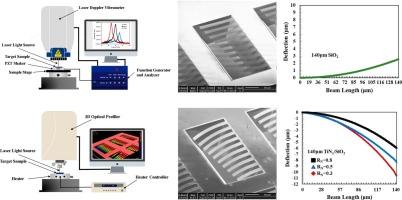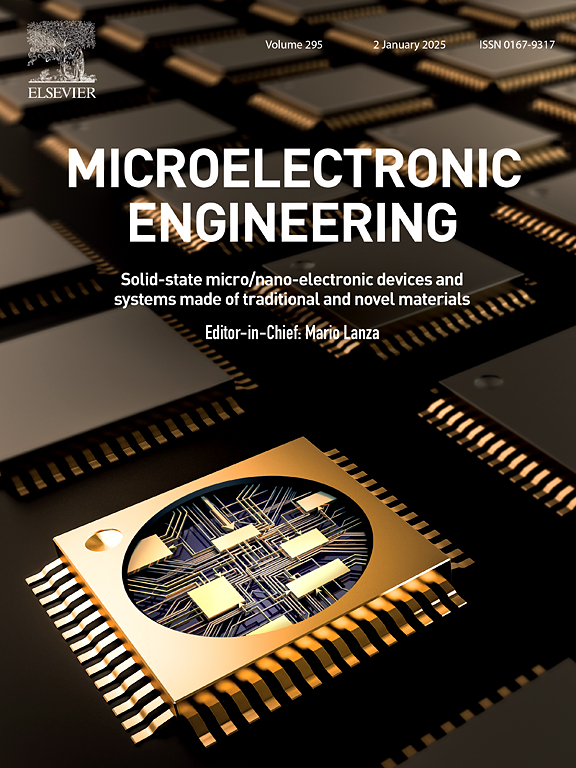On the mechanical properties of ultrathin titanium nitride films under different gas ratios of PVD process
IF 3.1
4区 工程技术
Q2 ENGINEERING, ELECTRICAL & ELECTRONIC
引用次数: 0
Abstract
Titanium Nitride (TiNx) thin film has numerous applications in semiconductors, nanotechnology, and various aspects of daily life. This study presents an approach to adjusting the mechanical properties of TiNx ultrathin films, including Young's modulus, residual stress, and coefficients of thermal expansion (CTE), by varying the gas ratio of N2 and Ar during the Physical Vapor Deposition (PVD) process (DC magnetron sputtering). In the experiment, TiNx films with three different gas ratios RN (= N2/(N2 + Ar)) were investigated. To demonstrate the feasibility of this approach, TiNx films with different RN values (0.3, 0.5, and 0.8) were deposited on SiO2 beams to form composite test cantilevers. Measurements reveal significant changes (ranging from 33 % to 2-fold) in Young's modulus, residual stress, and CTE of the TiNx films by varying the gas ratio during the PVD process. As a result, this study provides a straightforward approach and guidelines for users to tailor TiNx films according to specific application requirements.

论 PVD 工艺中不同气体比例下超薄氮化钛薄膜的力学性能
氮化钛(TiNx)薄膜在半导体、纳米技术和日常生活的各个方面有着广泛的应用。本研究提出了一种在物理气相沉积(PVD)过程(直流磁控溅射)中通过改变 N2 和 Ar 的气体比例来调整 TiNx 超薄薄膜机械性能的方法,包括杨氏模量、残余应力和热膨胀系数(CTE)。实验中研究了三种不同气体比例 RN(= N2/(N2 + Ar))的 TiNx 薄膜。为了证明这种方法的可行性,在二氧化硅梁上沉积了不同 RN 值(0.3、0.5 和 0.8)的 TiNx 薄膜,以形成复合测试悬臂。测量结果表明,通过在 PVD 过程中改变气体比例,TiNx 薄膜的杨氏模量、残余应力和 CTE 都发生了显著变化(从 33% 到 2 倍不等)。因此,这项研究为用户根据特定应用要求定制 TiNx 薄膜提供了直接的方法和指导。
本文章由计算机程序翻译,如有差异,请以英文原文为准。
求助全文
约1分钟内获得全文
求助全文
来源期刊

Microelectronic Engineering
工程技术-工程:电子与电气
CiteScore
5.30
自引率
4.30%
发文量
131
审稿时长
29 days
期刊介绍:
Microelectronic Engineering is the premier nanoprocessing, and nanotechnology journal focusing on fabrication of electronic, photonic, bioelectronic, electromechanic and fluidic devices and systems, and their applications in the broad areas of electronics, photonics, energy, life sciences, and environment. It covers also the expanding interdisciplinary field of "more than Moore" and "beyond Moore" integrated nanoelectronics / photonics and micro-/nano-/bio-systems. Through its unique mixture of peer-reviewed articles, reviews, accelerated publications, short and Technical notes, and the latest research news on key developments, Microelectronic Engineering provides comprehensive coverage of this exciting, interdisciplinary and dynamic new field for researchers in academia and professionals in industry.
 求助内容:
求助内容: 应助结果提醒方式:
应助结果提醒方式:


